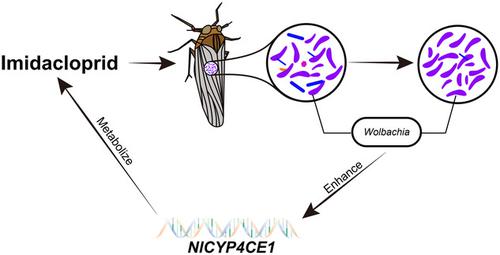当前位置:
X-MOL 学术
›
Insect Sci.
›
论文详情
Our official English website, www.x-mol.net, welcomes your
feedback! (Note: you will need to create a separate account there.)
Wolbachia enhances expression of NlCYP4CE1 in Nilaparvata lugens in response to imidacloprid stress
Insect Science ( IF 2.9 ) Pub Date : 2020-07-21 , DOI: 10.1111/1744-7917.12834 Tingwei Cai 1 , Yunhua Zhang 1 , Yu Liu 1 , Xiaoqian Deng 1 , Shun He 1 , Jianhong Li 1 , Hu Wan 1
Insect Science ( IF 2.9 ) Pub Date : 2020-07-21 , DOI: 10.1111/1744-7917.12834 Tingwei Cai 1 , Yunhua Zhang 1 , Yu Liu 1 , Xiaoqian Deng 1 , Shun He 1 , Jianhong Li 1 , Hu Wan 1
Affiliation

|
The brown planthopper, Nilaparvata lugens, is one of the main insect pests of rice. The N. lugens gene NlCYP4CE1 encodes cytochrome P450 monooxygenase (P450), which is a key enzyme in the metabolism of the insecticide imidacloprid. Previous research has suggested that the expression of NlCYP4CE1 is induced by imidacloprid stress, but the effect of bacterial symbionts on its expression has not been determined. The results of this study show that exposure to subtoxic imidacloprid changed the structure of the bacterial symbiont community in N. lugens. Specifically, the total bacterial content increased, but the bacterial species diversity decreased significantly. Wolbachia accounted for the largest proportion of bacteria in N. lugens; its abundance significantly increased after subtoxic imidacloprid exposure. The transcript level of NlCYP4CE1 was significantly increased by imidacloprid, but this effect was significantly weakened after Wolbachia was cleared with tetracycline. This result suggests that Wolbachia enhances the expression of NlCYP4CE1 to promote the detoxification metabolic response to imidacloprid stress. Understanding the effect of bacterial symbionts on gene expression in the host provides a new perspective on interactions between insecticides and their target insect pests, and highlights that subtoxic imidacloprid exposure may raise the risk of insecticide resistance by altering the structure of bacterial symbiont communities. This article is protected by copyright. All rights reserved.
中文翻译:

Wolbachia 增强 NlCYP4CE1 在 Nilaparvata lugens 中的表达以响应吡虫啉胁迫
褐飞虱 Nilaparvata lugens 是水稻的主要害虫之一。褐飞虱基因 NlCYP4CE1 编码细胞色素 P450 单加氧酶 (P450),它是杀虫剂吡虫啉代谢中的关键酶。以前的研究表明 NlCYP4CE1 的表达是由吡虫啉胁迫诱导的,但细菌共生体对其表达的影响尚未确定。这项研究的结果表明,暴露于亚毒吡虫啉会改变 N. lugens 中细菌共生群落的结构。具体而言,细菌总含量增加,但细菌物种多样性显着下降。Wolbachia 在 N. lugens 中的细菌比例最大;亚毒吡虫啉暴露后其丰度显着增加。NlCYP4CE1 的转录水平被吡虫啉显着增加,但在用四环素清除 Wolbachia 后这种作用显着减弱。该结果表明,Wolbachia 增强 NlCYP4CE1 的表达以促进对吡虫啉胁迫的解毒代谢反应。了解细菌共生体对宿主基因表达的影响为杀虫剂与其目标害虫之间的相互作用提供了新的视角,并强调了亚毒性吡虫啉暴露可能通过改变细菌共生体群落的结构来增加杀虫剂抗性的风险。本文受版权保护。版权所有。该结果表明,Wolbachia 增强 NlCYP4CE1 的表达以促进对吡虫啉胁迫的解毒代谢反应。了解细菌共生体对宿主基因表达的影响为杀虫剂与其目标害虫之间的相互作用提供了新的视角,并强调了亚毒性吡虫啉暴露可能通过改变细菌共生体群落的结构来增加杀虫剂抗性的风险。本文受版权保护。版权所有。该结果表明,Wolbachia 增强 NlCYP4CE1 的表达以促进对吡虫啉胁迫的解毒代谢反应。了解细菌共生体对宿主基因表达的影响为杀虫剂与其目标害虫之间的相互作用提供了新的视角,并强调了亚毒性吡虫啉暴露可能通过改变细菌共生体群落的结构来增加杀虫剂抗性的风险。本文受版权保护。版权所有。并强调了亚毒性吡虫啉暴露可能会通过改变细菌共生群落的结构来增加杀虫剂抗性的风险。本文受版权保护。版权所有。并强调了亚毒性吡虫啉暴露可能会通过改变细菌共生群落的结构来增加杀虫剂抗性的风险。本文受版权保护。版权所有。
更新日期:2020-07-21
中文翻译:

Wolbachia 增强 NlCYP4CE1 在 Nilaparvata lugens 中的表达以响应吡虫啉胁迫
褐飞虱 Nilaparvata lugens 是水稻的主要害虫之一。褐飞虱基因 NlCYP4CE1 编码细胞色素 P450 单加氧酶 (P450),它是杀虫剂吡虫啉代谢中的关键酶。以前的研究表明 NlCYP4CE1 的表达是由吡虫啉胁迫诱导的,但细菌共生体对其表达的影响尚未确定。这项研究的结果表明,暴露于亚毒吡虫啉会改变 N. lugens 中细菌共生群落的结构。具体而言,细菌总含量增加,但细菌物种多样性显着下降。Wolbachia 在 N. lugens 中的细菌比例最大;亚毒吡虫啉暴露后其丰度显着增加。NlCYP4CE1 的转录水平被吡虫啉显着增加,但在用四环素清除 Wolbachia 后这种作用显着减弱。该结果表明,Wolbachia 增强 NlCYP4CE1 的表达以促进对吡虫啉胁迫的解毒代谢反应。了解细菌共生体对宿主基因表达的影响为杀虫剂与其目标害虫之间的相互作用提供了新的视角,并强调了亚毒性吡虫啉暴露可能通过改变细菌共生体群落的结构来增加杀虫剂抗性的风险。本文受版权保护。版权所有。该结果表明,Wolbachia 增强 NlCYP4CE1 的表达以促进对吡虫啉胁迫的解毒代谢反应。了解细菌共生体对宿主基因表达的影响为杀虫剂与其目标害虫之间的相互作用提供了新的视角,并强调了亚毒性吡虫啉暴露可能通过改变细菌共生体群落的结构来增加杀虫剂抗性的风险。本文受版权保护。版权所有。该结果表明,Wolbachia 增强 NlCYP4CE1 的表达以促进对吡虫啉胁迫的解毒代谢反应。了解细菌共生体对宿主基因表达的影响为杀虫剂与其目标害虫之间的相互作用提供了新的视角,并强调了亚毒性吡虫啉暴露可能通过改变细菌共生体群落的结构来增加杀虫剂抗性的风险。本文受版权保护。版权所有。并强调了亚毒性吡虫啉暴露可能会通过改变细菌共生群落的结构来增加杀虫剂抗性的风险。本文受版权保护。版权所有。并强调了亚毒性吡虫啉暴露可能会通过改变细菌共生群落的结构来增加杀虫剂抗性的风险。本文受版权保护。版权所有。











































 京公网安备 11010802027423号
京公网安备 11010802027423号